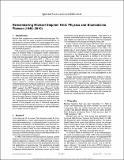| dc.contributor.author | Holbrow, Charles H. | |
| dc.date.accessioned | 2011-08-17T21:13:35Z | |
| dc.date.available | 2011-08-17T21:13:35Z | |
| dc.date.issued | 2011-01 | |
| dc.identifier.issn | 1083-3668 | |
| dc.identifier.uri | http://hdl.handle.net/1721.1/65190 | |
| dc.description.abstract | Michael Feld ranged over a wide intellectual landscape. During
his more than 50 years in physics and biomedicine, he
pioneered on several frontiers. His career began with fundamental
discoveries in laser science and ended as he was producing
exciting, innovative developments in biomedical optics
and biomedical physics.
Feld enjoyed crossing boundaries and savored diversity of
ideas, of research fields, of colleagues, and of collaborators.
His taste for intellectual variety was in notable contrast to his
fixed and long association with the Massachusetts Institute
of Technology (MIT). He entered MIT in 1958 as an undergraduate,
and except for a junior year in England, he never
left. Even when he took a sabbatical, he took it at MIT. It is as
though his firm anchor to one institution freed his imagination
and research to span many fields.
Michael Feld had a gift for building collaborations across
disciplines. He was director of MIT’s Harrison Spectroscopy
Laboratory from 1976 until his death on April 10, 2010, and
he made the Spectroscopy Laboratory a place that welcomed
scientists of all ages and nationalities and from many disciplines
(see Fig. 1). Under his direction, the laboratory became
a center for a variety of productive collaborations. He
institutionalized and increased funding for such cooperative
research by establishing, with National Science Foundation
(NSF) support, the MIT Regional Laser Research Facility,
and, with support from the National Institutes of Health (NIH),
the Laser Biomedical Research Center (LBRC). He worked
closely with collaborators from the Cleveland Clinic and from
Massachusetts General Hospital. He was an affiliated member
of the MIT–Harvard Health Sciences and Technology
(HST) program and supervised the doctoral work of men and
women in that program and also in chemical engineering,
bioengineering, and materials research, as well as in physics.
Many of his former students and postdocs have become leaders
in health science or physics. | en_US |
| dc.language.iso | en_US | |
| dc.publisher | Society of Photo-optical Instrumentation Engineers (SPIE) | en_US |
| dc.relation.isversionof | http://dx.doi.org/10.1117/1.3535591 | en_US |
| dc.rights | Article is made available in accordance with the publisher's policy and may be subject to US copyright law. Please refer to the publisher's site for terms of use. | en_US |
| dc.source | SPIE | en_US |
| dc.title | Remembering Michael Stephen Feld: Physics and Biomedicine Pioneer (1940–2010) | en_US |
| dc.type | Article | en_US |
| dc.identifier.citation | Holbrow, Charles H. "Remembering Michael Stephen Feld: Physics and Biomedicine Pioneer (1940–2010)", J. Biomed. Opt. 16, 011002 (Jan 31, 2011) © 2011 Society of Photo-Optical Instrumentation Engineers (SPIE) | en_US |
| dc.contributor.department | Massachusetts Institute of Technology. Department of Physics | en_US |
| dc.contributor.approver | Holbrow, Charles H. | |
| dc.contributor.mitauthor | Holbrow, Charles H. | |
| dc.relation.journal | Journal of Biomedical Optics | en_US |
| dc.eprint.version | Final published version | en_US |
| dc.type.uri | http://purl.org/eprint/type/JournalArticle | en_US |
| eprint.status | http://purl.org/eprint/status/PeerReviewed | en_US |
| dspace.orderedauthors | Holbrow, Charles H. | en |
| dc.identifier.orcid | https://orcid.org/0000-0003-3934-7055 | |
| mit.license | PUBLISHER_POLICY | en_US |
| mit.metadata.status | Complete | |
